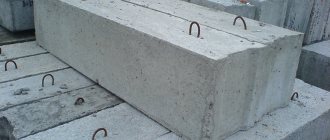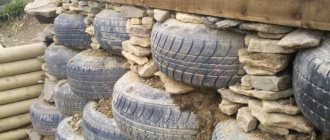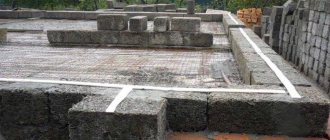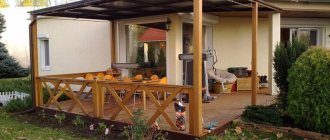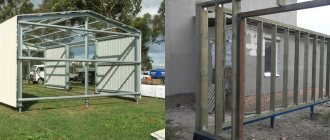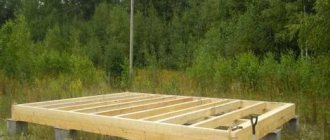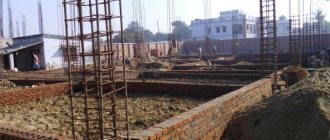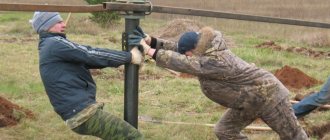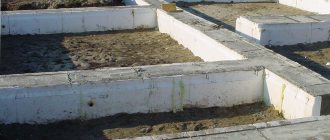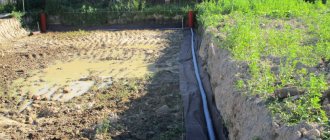Increasingly, building blocks made of expanded clay are being used to build garages, houses and cottages. They are mainly used as external cladding of load-bearing walls. The only thing you should pay attention to when constructing buildings from block material is the type of blocks that fits one or another part of the building. Thus, it is better to lay a foundation of expanded clay concrete blocks from solid products, and hollow ones are best suited for constructing the walls of a building.
Expanded clay concrete has been used for construction purposes not so long ago; in fact, it is a fairly new material. Expanded clay concrete products are made from a mixture of expanded clay with cement and sand. Advantages of expanded clay concrete products:
- Environmentally friendly material;
- The material is easy to use;
- Products are affordable.
Expanded clay concrete blocks are small in size, so building houses using this kind of materials with your own hands is not difficult.
Disadvantages of expanded clay material:
Expanded clay blocks in construction
- The material is quite fragile;
- The products have an ugly appearance;
- The material is greatly affected by sudden temperature changes.
Technical parameters and advantages of expanded clay concrete structure
Expanded clay concrete blocks are used to lay the foundation of the structure. Before moving on to their advantages, let's consider the main technical characteristics:
Density.
The average density ranges from 500 kg/m3 to 1800 kg/m3. It depends on the percentage of expanded clay to other components in the mixture - the smaller its quantity, the higher the density of the product.
Thermal conductivity.
With the use of large fractions, the product is more durable, but this increases its thermal conductivity. The thermal conductivity coefficient varies from 0.14 to 0.92 W/m°C.
Water absorption.
The water absorption coefficient is quite low compared to other materials. It averages about 15%.
Strength.
Even basement buildings are erected from expanded clay concrete blocks. Its strength depends on the density of the material, composition and manufacturing method.
Vapor permeability.
The material is able to “breathe”, thanks to which the structure is protected from the accumulation of excess moisture and possible destruction. Vapor permeability indicators are 0.09–0.3 mg/(m*h*Pa) depending on the amount of expanded clay in the blocks.
Block size.
The standard dimensions of expanded clay concrete blocks are 19 cm * 18.8 cm * 39 cm. This size is very convenient when calculating and laying a block foundation.
The undoubted advantage of expanded clay concrete is the ratio of its quality characteristics and the relatively low price of the material. In addition to this, it has the following advantages:
- fire resistance;
- durability (up to 400 years of operation);
- high strength and frost resistance;
- good heat and sound insulation;
- no shrinkage.
It is worth adding that due to its environmental friendliness, the material has absolutely no harmful effects on human health. The second name for expanded clay concrete is eco-concrete.
The availability of raw materials makes it possible to produce the material at home, but this will require certain construction skills. When purchasing expanded clay concrete blocks, you need to make sure that the manufacturer is reliable, since the ease of preparing the solution increases the risk of purchasing a low-quality product from self-taught craftsmen.
Ground floor - use of premises
Popular types of plinths with living rooms:
- A semi-basement basement is a type of foundation structure with a partial recess. The walls are built slightly above ground level. This method requires increased protection measures for a damp and cold environment, compared to a conventional basement. The influence of window openings in basement walls has a negative impact on the holding capacity of the foundation. But the uniqueness of the exterior presentation makes it possible to turn the semi-basement space into full-fledged living rooms. This plus outweighs all the disadvantages.
- Basement-basement is also a type of foundation. The construction involves complete deepening below ground level. This technique allows you to protect the walls of the room from cold and moisture. A significant disadvantage is that sunlight will not be able to penetrate into the interior. For this reason, such plinths are used not for residential purposes, but for technical premises - a boiler room, a utility room or a recreation area - a room for playing billiards, a swimming pool, a home cinema.
In addition, residential plinths are divided into objects with protruding or located flush with load-bearing walls. Projecting structures are erected under houses that do not have massive load-bearing walls.
Disadvantages of expanded clay concrete foundations
Technically, expanded clay concrete blocks are intended for the construction of walls, but practice shows that this material has proven itself well when laying foundations. However, expanded clay concrete also has weaknesses that should be taken into account before constructing the foundation of the structure.
One of the disadvantages of expanded clay concrete is its fragility. This applies to low and medium density material. Despite the ability of expanded clay concrete blocks to withstand heavy loads, experts still recommend using them for the construction of the foundation of one-story buildings, utility buildings, and garages.
Very often, when purchasing expanded clay concrete blocks from different manufacturers, it is possible to identify a discrepancy with the declared weight. This suggests that the material has different densities, which may subsequently affect its frost resistance and thermal conductivity.
When purchasing material from a trusted manufacturer and properly designing the foundation, the disadvantages of using expanded clay concrete blocks for these purposes can be reduced to zero.
Let's sum it up
Expanded clay concrete blocks have many advantages, due to which they are used for the construction of foundations. Although expanded clay concrete is a durable and reliable material, it can only be used for the construction of foundations designed for light loads.
The advantage of expanded clay concrete blocks is their high thermal insulation rates. Due to this, the material does not require additional thermal insulation. This way you save on consumables and the time it takes to build the foundation.
You can make an expanded clay block with your own hands, but it is important to strictly adhere to the instructions for its production, as well as observe the proportions of the components of the solution. If everything is done correctly, the mixture will ensure the strength of the structure for decades.
The use of expanded clay concrete for the construction of a block base
Expanded clay concrete has a low hygroscopicity coefficient, that is, it practically does not absorb moisture. This factor is an ideal condition for laying a block foundation.
All work on the construction of such a foundation is carried out in the same way as with a poured foundation. It is necessary to take into account the characteristics of the terrain, since this type of foundation is only suitable for dense soils with low groundwater levels.
The blocks are installed on a sand and gravel cushion, which should be on average 25 centimeters wider than the foundation. Laying is carried out using ordinary cement mortar. While working, you need to make sure that the seams do not match. The maximum height of such a foundation should be no more than 5 rows.
Advantages and disadvantages of a prefabricated strip foundation made of expanded clay concrete blocks
A prefabricated strip foundation made of expanded clay concrete can be erected independently by one person without outside help.
In addition to the speed of installation of such a foundation, the following advantages should be highlighted:
- relatively low financial costs;
- durability and wear resistance;
- resistance to temperature changes;
- high thermal insulation.
The lightness of the material allows installation without the use of special equipment.
The disadvantages of such a foundation include more pronounced shrinkage than a monolithic one, as well as the need to remove a large volume of soil.
Which foundation to choose for a house made of expanded clay concrete blocks
To decide on the choice of foundation for a house made of expanded clay concrete, you need to take into account the type of terrain, climate, soil characteristics and groundwater level, as well as the dimensions of the building.
If the groundwater is low, and the soil is stable and does not freeze very much, then a shallow foundation can be laid. When the soil is moving and the groundwater level is high, a more stable foundation for the structure is required.
The following types of foundation are suitable for a house made of expanded clay concrete blocks:
Tape reinforced concrete.
This type of foundation is laid with a continuous strip to a depth of approximately 1.5–1.7 meters, depending on the level of soil freezing. Concrete is poured into wooden formwork, and to increase strength, the foundation is reinforced with steel rods.
Pile-screw.
This type of foundation is characterized by speed of laying and low cost. Its construction begins with the deepening of metal piles into the ground. The length of the piles is selected taking into account the level of soil freezing. The pile-screw type of foundation is suitable for areas with highly mobile soil. For this purpose, piles with threads along the entire length are used. After installation, the piles are secured with beams made of wood or metal.
Slab.
This type of foundation is optimal in conditions of heaving soil, proximity to groundwater, and in wetlands. The base for a small-sized building usually consists of three layers:
- sand and gravel cushion;
- waterproofing layer;
- reinforced concrete slab.
The installation of this type of foundation is characterized by its high cost and high labor costs, so its installation must be justified by calculations.
Columnar.
This type of foundation is used in the construction of small buildings, for example, country houses. The columnar type of foundation is especially widely used in conditions of heavily frozen soil. Pillars can be made of different materials: brick, concrete, foam blocks, expanded clay blocks. To increase the strength of the foundation, you can install a reinforced concrete slab on the columns, which will withstand the load even on unstable soils.
Construction stages
- A layer of roofing material is laid on the foundation base, which will serve as excellent waterproofing.
- Next, concreting is carried out.
- Then solid expanded clay concrete panels are laid.
- Afterwards, a reinforcing mesh with 5x5 cm cells is installed on the first row.
- The next row is erected, where ventilation holes are formed; the recommended step size is 3 m with dimensions of 20x20 cm. It is also permissible to make ventilation in the third row.

- After the construction of the second row, waterproofing is carried out horizontally; for this it is better to use glued sheets of roofing felt, laying is done in half.
- The 3rd row is being built, reinforcement is made on top.
- On the fourth row, it is also necessary to make a waterproofing layer, but with hot bitumen mastic. Processing will need to be done in two layers.
- You will also need to provide additional horizontal moisture protection. The material should be glued to the upper area of the base in two layers.
- Waterproofing of the underground area is carried out with an overlap over the entire surface. The result should be a pillow of 10-15 cm, which will need to be compacted carefully.
The methodology for constructing the basement was described above, but there are also the following nuances:
- When building a basement, it is recommended to dig a hole under the building to install a communication system;
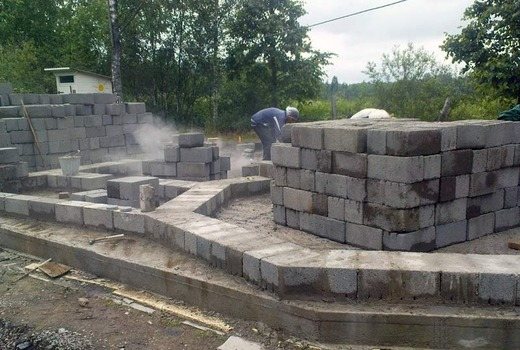
- After the pipes have been laid, a sand cushion should be created around them. Next, the trench is filled with soil. It is not uncommon for excavation work to be carried out before the foundation is poured. But in accordance with regulatory documents, it is recommended to do as described in the first paragraph;
- if the project has a garage next to the building, it will also be concreted and tied with reinforcement.
Installation of expanded clay concrete foundation
Most often, a strip foundation is used to lay a base of expanded clay concrete blocks. In this case, the following algorithm of actions is strictly observed:
- a trench is dug, the length of which must exceed the width of the blocks;
- the bottom of the pit is compacted tightly with sand;
- a durable concrete cushion is created;
- blocks are laid on cement mortar;
- Monolithic reinforced concrete is laid on top of the blocks;
- the final stage is waterproofing the outer side wall and the horizontal layer of the base.
Laying the foundation is one of the most serious and critical stages of construction, so it is better not to skimp on its construction. If you doubt your abilities, it is better to entrust this process to experienced specialists.
